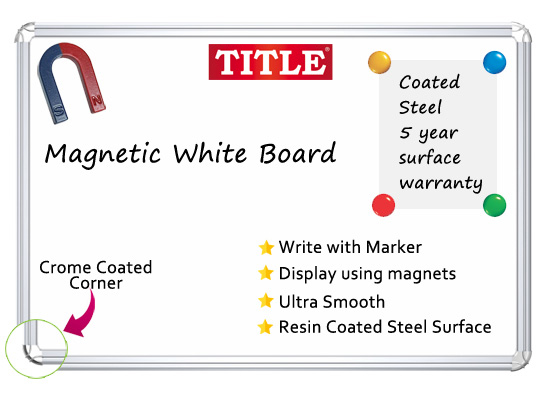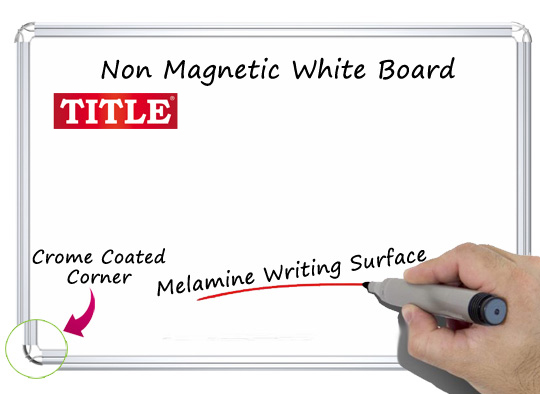

| White Magnetic Board : | Non Magnetic White Board : |
| Resing Coated Steel Surface | Melamine Writing Surface |
| Write With Marker | Write With Marker |
| Ultra Smooth | Not receptive to magne |
| Crome Coated Corner | Crome Coated Corner |
| Heavy Use | Moderate Use |
A white magnetic board, as the name suggests, is a type of whiteboard that has a magnetic surface. This means that it can hold magnets, allowing you to attach notes, papers, or other items to the board's surface. White magnetic boards are often used in schools, offices, and other settings where visual aids and presentations are common.
On the other hand, a non-magnetic whiteboard is a board that does not have a magnetic surface. It is made from materials such as melamine, porcelain, or glass, and is designed to be used with dry-erase markers. Non-magnetic whiteboards are also commonly used in schools, offices, and other settings where presentations are needed, but there is no need to attach anything to the board's surface using magnets.
The key difference between the two types of whiteboards is that magnetic boards are able to hold magnets, while non-magnetic boards are not. This makes magnetic boards more versatile and allows for more creative ways of displaying information. However, magnetic boards are generally more expensive than non-magnetic boards, and may be heavier and more difficult to install.
In summary, if you need a whiteboard that can hold magnets, a white magnetic board is the way to go. But if you don't need that feature, a non-magnetic whiteboard will work just fine and will likely be more affordable.
Magnetic whiteboards can be used by a variety of individuals and groups in various settings. Here are some examples: Educators, Business Professionals, Designers and Architects, Homeowners, Coaches and Trainers etc.

Non-magnetic whiteboards are widely used in various settings where visual aids and presentations are required. Here are some examples of how non-magnetic whiteboards can be used: Education, Business, Healthcare, Sports, Home, Art, Events etc.

When choosing between a white magnetic board and a non-magnetic whiteboard, there are several factors to consider. Here are some things to keep in mind:
Purpose: Consider the purpose of the board. If you need a board that can hold magnets, choose a white magnetic board. If you only need a board for writing or drawing, a non-magnetic whiteboard will suffice.
Size: Determine the size of the board you need based on the space available and the amount of information you need to display. Magnetic and non-magnetic boards come in various sizes, so choose one that suits your needs.
Material: Consider the material the board is made of. Magnetic whiteboards are typically made of steel or other magnetic materials, while non-magnetic whiteboards are made of materials such as melamine, porcelain, or glass. Choose a material that fits your needs and budget.
Durability: Consider the durability of the board. Magnetic whiteboards are often more durable than non-magnetic whiteboards due to the materials used to make them. However, non-magnetic whiteboards made of tempered glass or porcelain are more durable than those made of melamine.
Price: Compare the prices of different boards based on their size, material, and features. Magnetic whiteboards are generally more expensive than non-magnetic whiteboards, but the price may vary depending on the size and material.
Installation: Consider the installation requirements for the board. Magnetic whiteboards may be heavier and more challenging to install than non-magnetic whiteboards, so ensure that you have the necessary tools and assistance if needed.
In summary, when choosing between a white magnetic board and a non-magnetic whiteboard, consider the purpose, size, material, durability, price, and installation requirements to make an informed decision.
Magnetic whiteboards are a popular choice for offices because they offer a versatile tool for communication, collaboration, and organization. Here are some ways magnetic whiteboards can be used in offices:
Presentations: Magnetic whiteboards are great for presentations. Employees can use them to display graphs, charts, and other visual aids during meetings.
Brainstorming: Magnetic whiteboards are ideal for brainstorming sessions. Employees can use them to write ideas and move them around to create a cohesive plan.
Collaboration: Magnetic whiteboards are excellent tools for collaboration. Employees can attach sticky notes and documents using magnets to create a group workspace for ongoing projects.
Organizing: Magnetic whiteboards can be used for organizing schedules, deadlines, and tasks. They provide a visual way to manage workflows, allowing employees to stay on top of their priorities.
Communication: Magnetic whiteboards can be used for internal communication, such as posting memos, announcements, and important information. They provide a central location for employees to access critical information.
Training: Magnetic whiteboards can be used for employee training. Trainers can use them to display diagrams, flow charts, and other visual aids during training sessions.
Decoration: Magnetic whiteboards can be used to add a touch of personality to an office space. Employees can use them to display artwork, photos, or inspirational quotes.
In summary, magnetic whiteboards are versatile tools for offices. They can be used for presentations, brainstorming, collaboration, organizing, communication, training, and decoration. They provide an effective way to share ideas, manage workflows, and communicate with others in the office.
Non-magnetic whiteboards are commonly used in educational settings for presenting and illustrating course materials. Here are some ways non-magnetic whiteboards can be used in education:
Lectures: Non-magnetic whiteboards are often used during lectures to display diagrams, equations, and other visual aids. They provide an interactive way for instructors to engage with students and convey complex information.
Group Work: Non-magnetic whiteboards are useful for group work in classrooms. Students can use them to brainstorm ideas, organize their thoughts, and work collaboratively on projects.
Practice Exercises: Non-magnetic whiteboards are an effective way for students to practice solving equations, writing essays, or drawing diagrams. They can be easily erased and reused, allowing students to practice their skills repeatedly.
Storytelling: Non-magnetic whiteboards can be used for storytelling activities in early childhood education. Teachers can draw illustrations or write words to accompany stories, encouraging children to engage with the material.
Mind Mapping: Non-magnetic whiteboards are great for mind mapping activities, which help students to organize their ideas and create connections between concepts.
Review Sessions: Non-magnetic whiteboards can be used during review sessions to reinforce previously taught material. Instructors can use them to summarize key concepts or provide visual aids to help students remember important information.
Testing: Non-magnetic whiteboards can be used during testing to allow students to write their answers and calculations in a clear and organized manner. This allows instructors to quickly and easily evaluate student performance.
When choosing a non-magnetic whiteboard for educational purposes, consider factors such as durability, ease of cleaning, and resistance to ghosting. Also, think about the size and color of the board and how it will fit into your classroom or lecture hall.